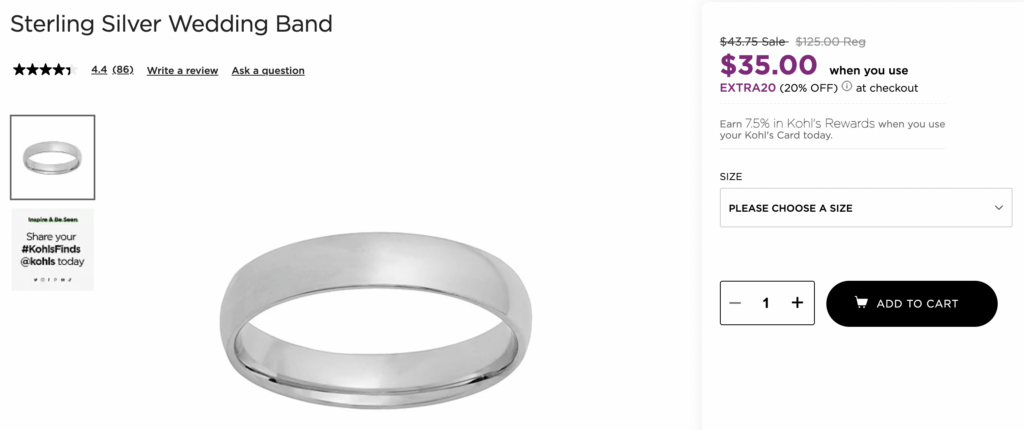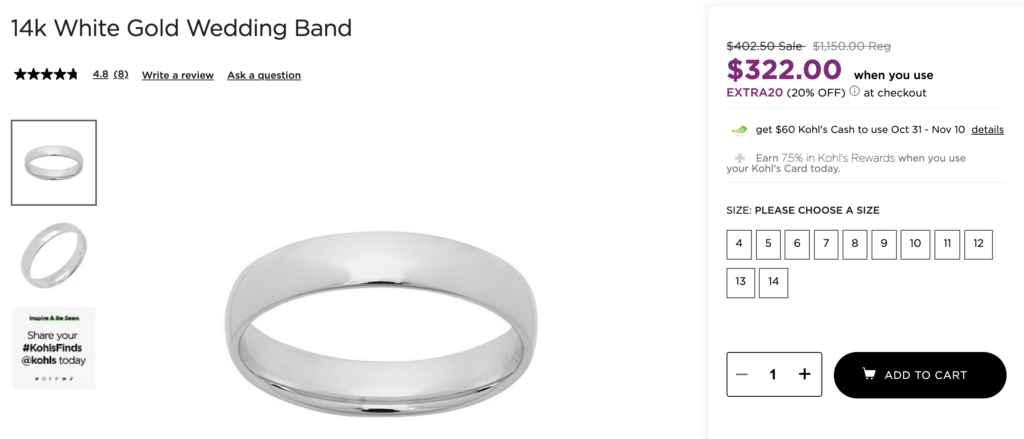If you have silver-colored jewelry, flatware, or other items, it can be difficult to determine whether your items are plated, white gold, or sterling silver.
Only pure and sterling silver is worth money for its silver content from metals buyers, while plated silver is typically not worth selling.
As of April 20, 2025, the silver resale value in the United States was at $32.48 per ounce, or $1.15 per gram.
Whether you’re looking to sell or shopping for silver jewelry, keep reading for a list of key differences between silver plated, sterling silver, and white gold:
Difference between silver plated and sterling silver
- How can you tell silver plated from sterling silver?
- Pros and cons of silver plated vs. sterling silver
- Silver plated vs sterling: Cost today vs. resale value
Sterling silver versus real silver
- Is sterling silver real silver?
- Which is more expensive: real or sterling silver?
- Is silver cheaper than sterling silver?
- What lasts longer: silver or sterling silver?
- Which is better: sterling silver or silver?
- How to tell if silver is real with ice
- How to tell if silver is real with a lighter
- How to tell if silver is real with acid
- How to tell if silver is real with a magnet
What is the difference between sterling silver and white gold?
- Difference between sterling silver and 14k white gold?
- Sterling silver vs white gold: Cost today vs. resale value
Where to sell real and sterling silver
Ready to sell your silver? Our top choice for selling silver is CashforSilverUSA, sister site of CashforGold, which boasts an A+ BBB rating and price match guarantee.
What is sterling silver?
Sterling silver is an alloy (a mixture of metals) made up of 92.5% pure silver and 7.5% other metals, typically copper or nickel, to increase durability. Just like 14k or 18k gold, sterling silver is blended with other metals to create longer-lasting products.
Sterling silver is also called 925 silver because of its 92.5% silver content.
Sterling silver is the most common silver that you will see for silver, flatware, serving pieces and most silver coins. It is strong, durable, beautiful and has some resale value.
Difference between silver plated and sterling silver
Unlike solid sterling silver, items that have silver plating are made of another metal such as copper, brass or nickel, and are covered with a thin layer of silver. Candlesticks made of silver plating often have plaster or cork inside.
In flatware, plated silver is also called “Hotel silver.” Learn more about flatware values and reselling in this guide.
It is not worth it to silver buyers to buy silver-plated items, though you may find some interest at an antique or thrift shop.
How can you tell silver plated from sterling silver?
Silver-plated items are often marked with an EP, EPNS or A1, while sterling silver is marked with a 925 based on its 92.5% pure silver content. Sterling silver from the U.K. may also be stamped with marks that indicate where it was made:

- Lion passant = England
- Standing lion = Glasgow
- Thistle = Edinburgh
- Crowned harp = Dublin
- Image of Britannia = Britannia silver (which is 95% pure)
The United States and most of the world follow the standard of 92.5%, though France and some other countries have a standard of 95%, or 950 silver. Learn more about stamps on jewelry.
These are some key differences between silver plated and sterling silver items:
| Silver plated | Sterling silver |
| Not hypoallergenic, especially when combined with nickel | Hypoallergenic |
| May be slightly lighter in color, with more shine | May be slightly darker in color, with less shine |
| Tends to be heavier because of base metals | Tends to be lighter |
| Less durable, since plating can chip and wear off, though the base metal underneath is considered more durable than sterling silver | More durable and scratch resistant |
Pros and cons of silver plated vs. sterling silver
There are some pros and cons to buying silver plated vs. sterling silver jewelry and other items:
Silver plated vs sterling: Color
While their difference may be subtle and virtually unnoticeable, silver plating tends to be slightly lighter in color than sterling silver, with more shine.
Silver plated vs sterling: Durability
Silver-plated items are more prone to chipping, scratching, and dulling, though the base metal under silver plating is considered more durable than sterling silver.
Sterling silver can tarnish when exposed to certain elements like chlorine and household chemicals, though it’s easy to clean in a solution of baking soda, salt, white vinegar, and boiling water. Plated silver can be cleaned but may need to be replated.
Silver plated vs sterling: Scratch resistance
Sterling silver is more scratch resistant than silver-plated items.
Sterling silver is easy to clean and polish, while silver-plated items will have to be replated to keep them looking new.
Silver plated vs sterling: Cost today vs. resale value
Sterling silver items typically cost more than those with silver plating because of their high precious metal content.
However, as far as resale value, sterling silver is worth 92.5% of the spot price of silver, while silver plating cannot be melted down for its silver content.
As of April 20, 2025, the silver resale value in the United States was at $32.48 per ounce, or $1.15 per gram.
Sterling silver versus real silver
100% silver in its purest form is relatively soft, which makes it susceptible to marks and scratches. Silver bullion in bars or coins is typically made of pure silver, while sterling is an alloy, pure silver mixed with alloys, to make it stronger and therefore usable in flatware, coins and jewelry.
Is sterling silver real silver?
Yes, sterling silver is pure silver mixed with a small percentage of another metal to make it more wearable and durable.
Which is more expensive: real or sterling silver?
Real sterling silver is more expensive than silver-plated, but less expensive than gold and white gold.
As of April 20, 2025, the silver resale value in the United States was at $32.48 per ounce, or $1.15 per gram.
As of , the spot gold value in the United States was trading at $ per ounce, or $ per gram.
Check out our post on how to tell the differences between sterling silver and white gold.
Is silver cheaper than sterling silver?
No, silver is not cheaper than sterling silver, simply because it contains a higher percentage of precious metal content — close to 100% silver vs. 92.5% silver in sterling silver.
At a price of $30.74 per ounce (the going rate as of December 15, 2024), a 1-ounce piece of silver would be worth about $31, while a 1-ounce piece of sterling silver would be worth about $28.
What lasts longer: silver or sterling silver?
Sterling silver is more durable than 100% silver because of the other metals added to it. That’s why it’s commonly used in jewelry and flatware over pure silver — it holds up better to everyday wear and tear.
While both may tarnish over time when exposed to elements like chlorine and household chemicals, they’re easy to clean in a solution of baking soda, salt, white vinegar, and boiling water. Both types of silver are also strong enough not to be broken with daily use.
Which is better: sterling silver or silver?
Based strictly on price, pure silver is more valuable than sterling silver. But unless you have silver bars or silver coins you want to part with, you’re more likely to have sterling silver in your china cabinet or jewelry box.
That’s because sterling silver outperforms when it comes to durability, which is why it’s more commonly used for everyday items like silver flatware and jewelry.
How to tell if silver is real
“Real silver,” and sterling silver can be vetted with these home tricks to ensure they are not plated silver, or another metal (or plastic):
How to tell if silver is real with ice
Because silver is highly conductive, it’s said to melt ice more quickly than other metals. If you put a piece of ice on the metal in question and on another piece of metal you know isn’t silver, the ice should melt more quickly than the other piece of ice if the object you’re testing is made of silver.
However, most silver enthusiasts say this test isn’t the most accurate, since a thick silver plating may produce the same results as sterling silver. Plus, other factors, like the size and thickness of the two objects you’re testing, can affect results.
Tip: The ice test isn’t a full-proof way to test if something is silver plated.
How to tell if silver is real with a lighter
Real silver turns black over time. You can speed up this process to test for silver by holding a lighter to its surface or by dipping it in vinegar. However, silver plating can also turn black using these testing methods, so you may have to scratch its surface first to test the metal under the outer surface.
Tip: The lighter test isn’t a full-proof way to test if something is silver plated.
How to tell if silver is real with acid
There are acid test kits available on Amazon to test for sterling silver vs. plated silver. When you drop acid on the silver plating, it’s stripped away to reveal the metal underneath.
Tip: You can buy an at-home acid test to check for silver plating.
This precious metal tester kit from Amazon is available for $21.49.
How to tell if silver is real with a magnet
Real silver is not magnetic. If you hold a magnet up to the object in question and it sticks, it is not sterling silver. However, silver-plated items made of copper and brass also will not stick to a magnet, so this test may only work on silver-plated nickel or other magnetic metals.
Tip: The magnet test is only effective on silver-plated nickel.
If you want to make sure what you have is sterling silver, you can bring it to a local jeweler or silversmith, who will likely perform a professional acid test or examine the metal for indicative markings.
Search for local jewelers:

Search for silversmiths:

This video goes over some of the ways to identify sterling silver vs. plated silver cutlery:
5 silver bar buyers where you can sell silver
These are some other tips for testing silver from Reddit:
what’s the best way to quickly check if silver is real?
byu/PuertoRock007 inSilverbugs
Comment
byu/PuertoRock007 from discussion
inSilverbugs
Comment
byu/PuertoRock007 from discussion
inSilverbugs
What is the difference between sterling silver and white gold?
Sterling silver and white gold are both alloys (a mixture of metals), but they’re made up of different metals:
- Sterling silver = 92.5% pure silver + other metals (typically copper or nickel)
- White gold = 58.3%-99% pure gold (varies) + other metals (typically silver, nickel, palladium, or zinc)
White gold is also usually plated with a layer of rhodium (a rare platinum group metal), which gives it its white appearance and prevents the gold from scratching.
What’s the difference between sterling silver and 14k white gold?
Sterling silver is made up of 92.5% pure silver, and 14k white gold is made up of 58.3% pure gold. Both are mixed with other metals to increase durability.
Sterling silver vs white gold: Color
Sterling silver is typically slightly brighter white than white gold. Unplated white gold may also have a slightly yellow sheen from its gold content.
Sterling silver vs white gold: Durability
Because it’s often plated in rhodium — which makes it resistant to scratches and dents — white gold is considered more durable than sterling silver.
Sterling silver vs white gold: Scratch resistance
Rhodium plating on white gold makes it more scratch resistant than sterling silver, though it must be replated every six months to a year to retain its appearance and protective quality, according to New York City jeweler Frank Darling.
Sterling silver vs white gold: Maintenance
Both sterling silver and white gold need regular maintenance to retain their optimal appearance:
- Sterling silver: Sun exposure, lotions, makeup, chlorine, cleaning products, and more outside factors can cause sterling silver to tarnish. To keep your sterling silver in tip top shape, make a paste of baking soda and water and lightly scrub your jewelry with a cloth, or place your jewelry in a mixture of ½ cup of white vinegar and 2 tbsp of baking soda for a couple of hours.
- White gold: If you want your white gold to maintain its pure white appearance, you should have it re-plated in rhodium every six months to a year, which typically costs between $50-$100, depending on the jeweler and how thick the plating is.
Sterling silver vs white gold: Cost today vs. resale value
While sterling silver costs significantly less than white gold and it has a lower resale value. This post details the difference retail and resale prices of yellow vs white gold.
These two nearly identical wedding bands from Kohls have a price difference of almost $300:


If you’re not sure whether your jewelry is sterling silver or white gold, you can have it evaluated by CashforGoldUSA.
Where to sell real and sterling silver
This post details top silver buyers, while these articles detail our writer’s investigation into selling jewelry to pawn shops and local scrap gold buyers.
Our top choice for selling sterling silver is CashforSilverUSA, sister site of CashforGold, which boasts an A+ BBB rating and price match guarantee. We also like CashforSilver because:
- Payouts within 24 hours of offer acceptance
- 10% bonus if you send in your silver within a week of receiving your mailer
- Free shipping label and insurance up to $150,000
- Risk-free cancellation and free shipping back to you
CashforSilver accepts all forms of silver, gold, platinum, diamonds, and gemstones, including:
- Silver coins
- Silver jewelry
- Scrap silver
- Silverware
- Silver flatware
Like most buyers, this company does not accept plated silver.
CashforSilverUSA does not buy plated items. Read our review of sister site CashforGoldUSA.
Get a free quote from CashforSilverUSA today >>
Who buys silver plated?
Unless you have a large quantity of silver-plated items — like silver-plated flatware, platters, or dishes — you likely won’t get much, if any, money for them. However, these are some places where you can sell silver-plated items, especially if they hold value as a collector’s item:
- Pawn shops
- Auction houses
- Online marketplaces like ebay and Craigslist
- Facebook Marketplace
- Antiques dealers
- ebay
- Some online precious metals buyers if you have large quantities of silver-plated items
You can also donate your silver-plated items to a thrift store, though you won’t be paid, but may qualify for a tax deduction.
If you’re asking “Where can I sell silver-plated items near me?” or “Who buys silver plated stuff near me?” you may be able to find a local pawn shop or antiques dealer to buy your items depending on their age, make, and quality.
Search for pawn shops:

Search for antiques dealers:

Who buys white gold?
Most gold buyers — online and “near me” will also buy white gold, as well as any sizable diamonds they may contain. Learn more in our guide to selling gold.
While silver prices are strong, gold of all colors is at a record high.
As of April 20,2025, the spot gold value in the United States was trading at $3317.23 per ounce, or $117.01 per gram.
Plated silver may be worth money as a collector’s item depending on its make, age, and quality. However, plated silver is not typically worth money for its silver content, unless it’s sold in large quantities.
Yes, silver-plated items can tarnish over time. You can try cleaning the pieces with jewelry polish or soak them in a mixture of baking soda, salt, white vinegar, and boiling water.
Yes, silver plating does wear off over time. You can take your item to be replated at a jeweler or try an at-home solution.
In terms of resale value, durability, and longevity, sterling silver is better than plated silver.
At first glance, white gold and sterling silver do look almost the same, though sterling silver may be a slightly brighter white. If it isn’t plated in rhodium, white gold may have a slightly yellow appearance.
White gold is stronger and more scratch resistant than sterling silver, though it does cost more money.
Because of its rhodium plating, white gold is more durable and therefore may last longer than sterling silver with regular replating.
In terms of resale value, white gold is worth more than sterling silver because the price of gold is higher than the price of silver.

